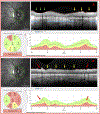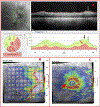Optical Coherence Tomography Can Be Used to Assess Glaucomatous Optic Nerve Damage in Most Eyes With High Myopia
- PMID: 33006872
- PMCID: PMC7534586
- DOI: 10.1097/IJG.0000000000001631
Optical Coherence Tomography Can Be Used to Assess Glaucomatous Optic Nerve Damage in Most Eyes With High Myopia
Abstract
Precis: It is generally assumed that optical coherence tomography (OCT) cannot be used to diagnose glaucomatous optic neuropathy (GON) in high myopes. However, this study presents evidence that there is sufficient information in OCT scans to allow for accurate diagnosis of GON in most eyes with high myopia.
Purpose: The purpose of this study was to test the hypothesis that glaucomatous damage can be accurately diagnosed in most high myopes via an assessment of the OCT results.
Patients and methods: One hundred eyes from 60 glaucoma patients or suspects, referred for OCT scans and evaluation, had corrected spherical refractive errors worse than -6 D and/or axial lengths ≥26.5 mm. An OCT specialist judged whether the eye had GON, based upon OCT circle scans of the disc and cube scans centered on the macula. A glaucoma specialist made the same judgement using all available information (eg, family history, repeat visits, intraocular pressure, 10-2 and 24-2 visual fields, OCT). A reference standard was created based upon the glaucoma specialist's classifications. In addition, the glaucoma specialist judged whether the eyes had peripapillary atrophy (PPA), epiretinal membrane (ERM), tilted disc (TD), and/or a paravascular inner retinal defect (PIRD).
Results: The OCT specialist correctly identified 97 of the 100 eyes using the OCT information. In 63% of the cases, the inner circle scan alone was sufficient. For the rest, additional scans were requested. In addition, 81% of the total eyes had: PPA (79%), ERM (18%), PIRD (26%), and/or TD (48%).
Conclusions: For most eyes with high myopia, there is sufficient information in OCT scans to allow for accurate diagnosis of GON. However, the optimal use of the OCT will depend upon training to read OCT scans, which includes taking into consideration myopia related OCT artifacts and segmentation errors, as well as PPA, ERM, PIRD, and TD.
Figures











Similar articles
-
Diagnostic Accuracy of Optic Nerve Head and Macula OCT Parameters for Detecting Glaucoma in Eyes With and Without High Axial Myopia.Am J Ophthalmol. 2024 Oct;266:77-91. doi: 10.1016/j.ajo.2024.04.022. Epub 2024 May 15. Am J Ophthalmol. 2024. PMID: 38754801
-
Development of Topographic Scoring System for Identifying Glaucoma in Myopic Eyes: A Spectral-Domain OCT Study.Ophthalmology. 2018 Nov;125(11):1710-1719. doi: 10.1016/j.ophtha.2018.05.002. Epub 2018 Jun 7. Ophthalmology. 2018. PMID: 29887333
-
From Machine to Machine: An OCT-Trained Deep Learning Algorithm for Objective Quantification of Glaucomatous Damage in Fundus Photographs.Ophthalmology. 2019 Apr;126(4):513-521. doi: 10.1016/j.ophtha.2018.12.033. Epub 2018 Dec 20. Ophthalmology. 2019. PMID: 30578810 Free PMC article.
-
On improving the use of OCT imaging for detecting glaucomatous damage.Br J Ophthalmol. 2014 Jul;98 Suppl 2(Suppl 2):ii1-9. doi: 10.1136/bjophthalmol-2014-305156. Br J Ophthalmol. 2014. PMID: 24934219 Free PMC article. Review.
-
High Myopia and Glaucoma-Like Optic Neuropathy.Asia Pac J Ophthalmol (Phila). 2020 May-Jun;9(3):234-238. doi: 10.1097/APO.0000000000000288. Asia Pac J Ophthalmol (Phila). 2020. PMID: 32459697 Free PMC article. Review.
Cited by
-
The OCT RNFL Probability Map and Artifacts Resembling Glaucomatous Damage.Transl Vis Sci Technol. 2022 Mar 2;11(3):18. doi: 10.1167/tvst.11.3.18. Transl Vis Sci Technol. 2022. PMID: 35289836 Free PMC article.
-
Advances in OCT Imaging in Myopia and Pathologic Myopia.Diagnostics (Basel). 2022 Jun 8;12(6):1418. doi: 10.3390/diagnostics12061418. Diagnostics (Basel). 2022. PMID: 35741230 Free PMC article. Review.
-
Addressing Glaucoma in Myopic Eyes: Diagnostic and Surgical Challenges.Bioengineering (Basel). 2023 Oct 29;10(11):1260. doi: 10.3390/bioengineering10111260. Bioengineering (Basel). 2023. PMID: 38002384 Free PMC article. Review.
-
Ab-externo canaloplasty with and without suture in highly myopic eyes.Int Ophthalmol. 2023 Oct;43(10):3695-3705. doi: 10.1007/s10792-023-02779-y. Epub 2023 Jul 6. Int Ophthalmol. 2023. PMID: 37415019
-
Comprehensive assessment of glaucoma in patients with high myopia: a systematic review and meta-analysis with a discussion of structural and functional imaging modalities.Int Ophthalmol. 2024 Oct 11;44(1):405. doi: 10.1007/s10792-024-03321-4. Int Ophthalmol. 2024. PMID: 39392516 Free PMC article.
References
-
- Weinreb RN, Leung CK, Crowston JG, et al. Primary open-angle glaucoma. Nat Rev Dis Primers. 2016;2:16067. - PubMed
-
- Henaine-Berra A, Zand-Hadas IM, Fromow-Guerra J, Garcia-Aguirre G. Prevalence of macular anatomic abnormalities in high myopia. Ophthalmic Surg Lasers Imaging Retina. 2013;44(2):140–144. - PubMed
-
- Liu W, Gong L, Li Y, Zhu X, Stewart JM, Wang C. Peripapillary Atrophy in High Myopia. Curr Eye Res. 2017;42(9):1308–1312. - PubMed
-
- Muraoka Y, Tsujikawa A, Hata M, et al. Paravascular inner retinal defect associated with high myopia or epiretinal membrane. JAMA Ophthalmol. 2015;133(4):413–420. - PubMed
Publication types
MeSH terms
Grants and funding
LinkOut - more resources
Full Text Sources
Medical

